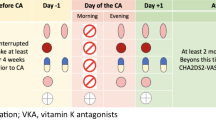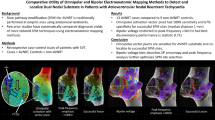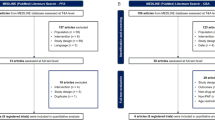Abstract
Catheter ablation of atrial fibrillation (AF) has made considerable advances over the past decade. Although pulmonary vein (PV) isolation has proven to be a reliable curative treatment, especially for paroxysmal AF, it still has several issues to resolve. Because the AF mechanisms are complex and multifactorial, especially in persistent or permanent AF, they cannot be eliminated altogether by PV isolation alone. Beyond PV isolation, several other techniques have shown promise in improving the long-term success. Several recent reports comparing the superiority between AF ablation and antiarrhythmic drug therapy have shown early evidence suggesting that AF ablation warrants consideration as a first-line therapy in selected patients.
Similar content being viewed by others
References and Recommended Reading
Haïssaguerre M, Jaïs P, Shah DC, et al.:Spontaneous initiation of atrial fibrillation by ectopic beats originating in the pulmonary veins.N Engl J Med 1998,339:659–666.
Haïssaguerre M, Shah DC, Jaïs P, et al.:Electrophysiological breakthroughs from the left atrium to the pulmonary veins.Circulation 2000,102:2463–2465.
Pappone C, Rosanio S, Oreto G, et al.:Circumferential radiofrequency ablation of pulmonary vein ostia: a new anatomic approach for curing atrial fibrillation.Circulation 2000,102:2619–2628.
Nademanee K, McKenzie J, Kosar E, et al.:A new approach for catheter ablation of atrial fibrillation: mapping of the electrophysiologic substrate.J Am Coll Cardiol 2004,43:2044–2053.
Oral H, Christoph S, Chugh A, et al.:Catheter ablation for paroxysmal atrial fibrillation: segmental pulmonary vein ostial ablation versus left atrial ablation.Circulation 2003,108:2355–2360.
Ouyang F, Bänsch D, Ernst S, et al.:Complete isolation of left atrium surrounding the pulmonary veins. New insights from the Double-Lasso technique in paroxysmal atrial fibrillation.Circulation 2004,110:2090–2096.
Of importance Oral H, Chugh A, Good E, et al.:A tailored approach to catheter ablation of paroxysmal atrial fibrillation.Circulation 2006,113:1824–1831. This study demonstrated that a patient-tailored ablation strategy that only targeted triggers and drivers of AF was feasible and could achieve a high cure rate in patients with paroxysmal AF.
Gerstenfeld EP, Callans DJ, Dixit S, et al.:Mechanisms of organized left atrial tachycardias occurring after pulmonary vein isolation.Circulation 2004,110:1351–1357.
Pappone C, Oral H, Santinelli V, et al.:Atrio-esophageal fistula as a complication of percutaneous transcatheter ablation of atrial fibrillation.Circulation 2004,109:2724–2726.
Allessie MA, Boyden PA, Camm AJ, et al.:Pathophysiology and prevention of atrial fibrillation.Circulation 2001,103:769–777.
Ouyang F, Antz M, Ernst S, et al.:Recovered pulmonary vein conduction as a dominant factor for recurrent atrial tachyarrhythmias after complete circular isolation of the pulmonary veins: lessons from double Lasso technique.Circulation 2005,111:127–135.
Mesas CE, Pappone C, Lang CCE, et al.:Left atrial tachycardia after circumferential pulmonary vein ablation for atrial fibrillation. Electroanatomic characterization and treatment.J Am Coll Cardiol 2004,44:1071–1079.
Verma A, Marrouche NF, Natale A:Pulmonary vein antrum isolation: intracardiac echocardiography-guided technique.J Cardiovasc Electrophysiol 2004,15:1335–1340.
Yamada T, Murakami Y, Okada T, et al.:Electrophysiological pulmonary vein antrum isolation with a multielectrode basket catheter is feasible and effective for curing paroxysmal atrial fibrillation: efficacy of minimally extensive pulmonary vein isolation.Heart Rhythm 2006,3:377–384.
Oral H, Knight BP, Tada H, et al.:Pulmonary vein isolation for paroxysmal and persistent atrial fibrillation.Circulation 2002,105:1077–1081.
Scharf C, Oral H, Chugh A, et al.:Acute effects of left atrial radiofrequency ablation on atrial fibrillation.J Cardiovasc Electrophysiol 2004,15:515–521.
Of importance Haïssaguerre M, Hocini M, Sanders P, et al.:Localized sources maintaining atrial fibrillation organized by prior ablation.Circulation 2006,113:616–625. A study showing endocardial mapping and ablation of localized sources driving AF in the atrium.
Rostock T, Rotter M, Sanders P, et al.:Fibrillating areas isolated within the left atrium after radiofrequency linear catheter ablation.J Cardiovasc Electrophysiol 2006,17:807–812.
Takahashi Y, Sanders P, Jaïs P, et al.:Organization of frequency spectra of atrial fibrillation: relevance to radiofrequency catheter ablation.J Cardiovasc Electrophysiol 2006,17:382–388.
O’Neill MD, Jaïs P, Takahashi Y, et al.:The stepwise ablation approach for chronic atrial fibrillation—evidence for a cumulative effect.J Interv Card Electrophysiol 2006,16:153–167.
Coumel P, Attuel P, Lavallee J, et al.:The atrial arrhythmia syndrome of vagal origin.Arch Mal Coeur Vaiss 1978,71:645–656.
Zipes DP, Mihalick MJ, Robbins GT:Effects of selective vagal and stellate ganglion stimulation of atrial refractoriness.Cardiovasc Res 1974,8:647–655.
Liu L, Natel S:Differing sympathetic and vagal effect on atrial fibrillation in dogs: role of refractoriness heterogeneity.Am J Physiol 1997,273:H805-H816.
Scherlag BJ, Yamanashi WS, Schauerte P, et al.:Endovascular stimulation within the left pulmonary artery to induce slowing of heart rate and paroxysmal atrial fibrillation.Cardiovasc Res 2002,54:470–475.
Schauerte P, Scherlag BJ, Pitha J, et al.:Catheter ablation of cardiac autonomic nerves for prevention of vagal atrial fibrillation.Circulation 2000,102:2774–2779.
Pappone C, Santinelli V, Manguso F, et al.:Pulmonary vein denervation enhances long-term benefit after circumferential ablation for paroxysmal atrial fibrillation.Circulation 2004,109:327–334.
Armour JA, Murphy DA, Yuan BX, et al.:Gross and microscopic anatomy of the human intrinsic cardiac nervous system.Anat Rec 1997,247:289–298.
Pauza DH, Skripka V, Pauziene N, Stropus R:Morphology, distribution, and variability of the epicardial neural ganglionated subplexuses in the human heart.Anat Rec 2000,259:353–382.
Scherlag BJ, Nakagawa H, Jackman WM, et al.:Electrical stimulation to identify neural elements on the heart: their role in atrial fibrillation.J Interv Card Electrophysiol 2005,13(Suppl 1):37–42.
Of importance Scanavacca M, Pisani CF, Hachul D, et al.:Selective atrial vagal denervation guided by evoked vagal reflex to treat patients with paroxysmal atrial fibrillation.Circulation 2006,114:876–885. This study demonstrated that selective atrial vagal denervation alone could prevent AF recurrences in selected patients with apparently vagal-induced paroxysmal AF.
Oh S, Zhang Y, Bibevski S, et al.:Vagal denervation and atrial fibrillation inducibility: epicardial fat pad ablation does not have long-term effects.Heart Rhythm 2006,3:701–708.
Of importance Nakagawa H, Antz M, Wong T, et al.:Initial experience using a forward directed, high-intensity focused ultrasound balloon catheter for pulmonary vein antrum isolation in patients with atrial fibrillation.J Cardiovasc Electrophysiol 2007,18:136–144. A study showing the efficacy of PV isolation with a high-intensity focused ultrasound balloon catheter.
Garan A, Al-Ahmad A, Mihalik T, et al.:Cryoablation of the pulmonary veins using a novel balloon catheter.J Interv Card Electrophysiol 2006,15:79–81.
Wazni OM, Marrouche NF, Martin DO, et al.:Radiofrequency ablation vs antiarrhythmic drugs as first-line treatment of symptomatic atrial fibrillation: a randomized trial.JAMA 2005,293:2634–2640.
Stabile G, Bertaglia E, Senatore G, et al.:Catheter ablation treatment in patients with drug-refractory atrial fibrillation: a prospective, multi-centre, randomized, controlled study (Catheter Ablation For The Cure Of Atrial Fibrillation Study).Eur Heart J 2006,27:216–221.
Of importance Oral H, Pappone C, Chugh A, et al.:Circumferential pulmonary-vein ablation for chronic atrial fibrillation.N Engl J Med 2006,354:934–941. This study demonstrated that circumferential PV ablation was more effective than amiodarone in maintaining sinus rhythm, even in patients with permanent AF.
Of importance Pappone C, Augello G, Sala S, et al.:A randomized trial of circumferential pulmonary vein ablation versus antiarrhythmic drug therapy in paroxysmal atrial fibrillation: the APAF Study.J Am Coll Cardiol 2006,48:2340–2347. This study demonstrated that circumferential PV ablation alone was superior to antiarrhythmic drug therapy for maintaining sinus rhythm in patients with a long history of paroxysmal AF who had failed antiarrhythmic drug therapy.
Author information
Authors and Affiliations
Corresponding author
Rights and permissions
About this article
Cite this article
Yamada, T., Kay, G.N. Evidence-based approach to ablating atrial fibrillation. Curr Cardiol Rep 9, 366–370 (2007). https://doi.org/10.1007/BF02938363
Issue Date:
DOI: https://doi.org/10.1007/BF02938363




